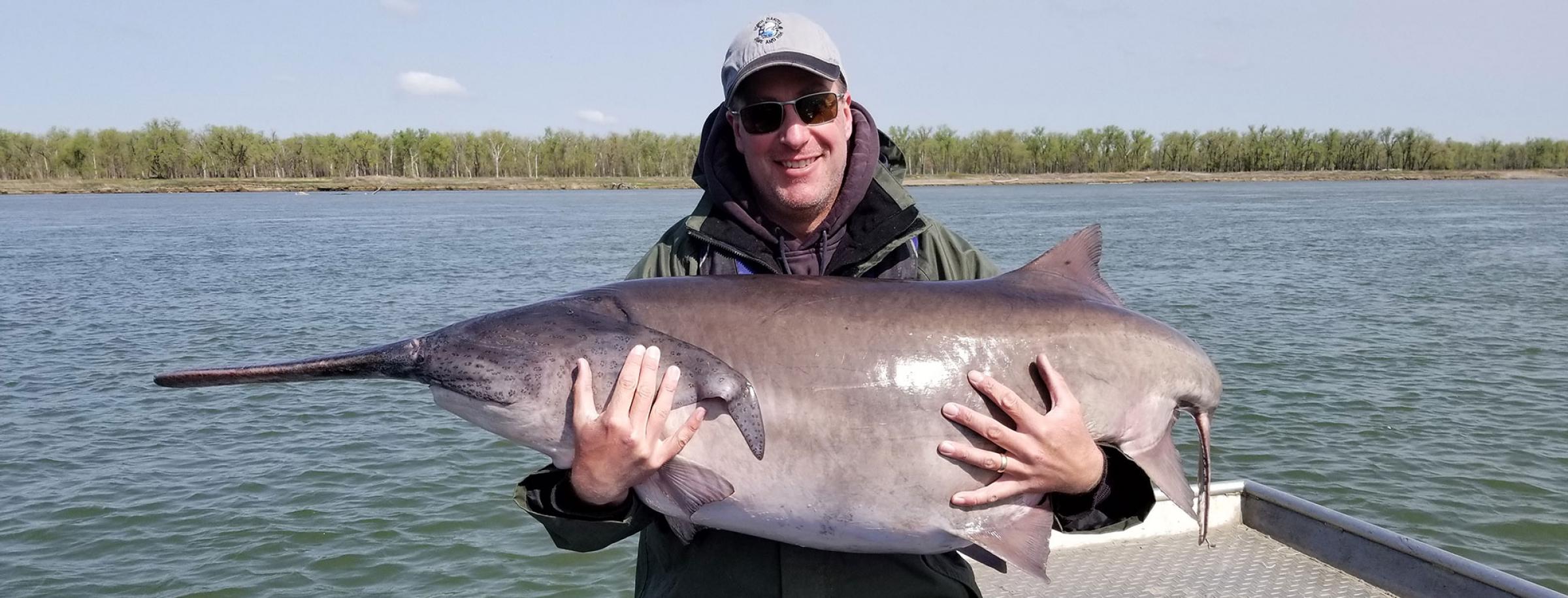
Back Cast
The nature of the 200-mile stretch of Missouri River changed when construction of Oahe Dam was completed in 1962, nine years after Garrison Dam, its upstream equivalent.
A river that once ran unchecked, rising and falling following the seasonal whims of Mother Nature, was now harnessed by two enormous dams.
Eventually, regulated flows out of Garrison Dam created a cooler, clearer river environment and a top-shelf walleye fishery between the two impoundments.
Nearly lost with the disappearance of the once warm, turbid river environment are native species such as blue suckers and pallid sturgeon. Not lost, but largely forgotten for years, is a fish species that, if for no other reason than its age-old ties to the river, brings value to its surroundings.
Since 2006, following just one effort in 1994 to sample this population, North Dakota Game and Fish Department fisheries biologists have netted and tagged thousands of paddlefish that swim mostly unmolested in the Garrison reach, save for the occasional fish snagged by unsuspecting anglers or hit by recreational boaters.
“Over the last decade or so, we’ve devoted quite a bit of effort to try and learn more about this paddlefish population that exists between Garrison and Oahe dams,” said Paul Bailey, Department district fisheries supervisor. “Paddlefish are a species of conservation priority for us, and throughout most of their range in North America, they’re not doing very well. So, it’s important to learn more about this paddlefish population to make sure we’re doing what we can to manage them appropriately.”
Bailey said it’s estimated that paddlefish number anywhere from 9,000 to 12,000 during spring sampling north of Bismarck. Yet, because not all male or female paddlefish point their rostrums, or paddles, upstream every year to make ineffective spawning runs out of the Oahe headwaters, the 9,000 to 12,000 fish surprisingly represent about half the population.
These spring paddlefish spawning runs are deemed ineffective in the Garrison reach because fisheries biologists have yet to find any evidence of natural reproduction. Paddlefish sandwiched between the dams are primarily fish that passed through Garrison Dam over time.
“These fish are attempting to spawn, but likely not having any success at it because of cold water temperatures and highly altered flow regimes out of Lake Sakakawea,” Bailey said.
While paddlefish that inhabit the cool waters downstream of Garrison Dam aren’t reproducing, those that exist above the dam and into the headwaters of Lake Sakakawea do successfully spawn in spring in the Missouri and Yellowstone rivers. This naturally reproducing population supports North Dakota’s only snag fishery.
Paddlefish, no matter where they swim in the Missouri River System, are an interesting fish. They are long-lived, have a mostly cartilaginous anatomy and, of course, sport an elongated, flat, paddle-shaped rostrum.
Paddlefish also grow to impressive sizes. The state record, snagged near the confluence of the Yellowstone and Missouri rivers, measured 71 inches and weighed 131 pounds. Fisheries biologists have netted paddlefish over 120 pounds in the Garrison reach.
“Paddlefish are North Dakota’s largest fish and they feed on zooplankton, the smallest of prey at the bottom of the food chain,” Bailey said. “They are a great indicator species for the overall health of the upper portion of Lake Oahe where they spend most of the year. When times are good in Oahe, zooplankton is abundant and the paddlefish are pretty fat and happy. On the flip side, when you go through events like the 2011 flood or a period of drought, zooplankton productivity drops of and the paddlefish become much skinnier.”
What remains to be seen, as other paddlefish populations in North America continue to struggle because of the degradation of habitat, is how long these ancient fish swimming in North Dakota will endure.
